Fibre Bundles
John Robinson has explained in discussing ETERNITY how he was fascinated by the Möbius Band, and the way it can
be seen as a line segment twisting as it moves around a circle.
Instead of a line segment, different shapes can be moved round
a circle, and with a twist of various amounts. These shapes may
match up, but it depends on the shape you start with, and the
amount of twist. In this way John discovered a general concept
which is very important in mathematics, that of a fibre bundle.
The structure of a fibre bundle consists of a base, which for the Möbius Band and other of John's sculptures, is
a circle. The fibre is the form of the shape which is moved around the circle. The
extra data to describe the object is the amount of twist in the fibre as it moves round the circle. This amount of twist
has to be related to the shape of the fibre, so that the fibres
match. For a Möbius Band, the fibre is just a line segment and
the twist is 180 degrees.
| For a fibre with three fold symmetry, such as a triangle, the
twist could be any whole number multiple, including zero, of 120
degrees. A twist of exactly 120 degrees gives John's sculpture
ETERNITY. This sculpture can be seen in the steps of construction below,
which shows clearly the triangular fibre of the fibre bundle,
and the way the fibres fit together. |
|
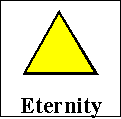 |
The making of Eternity
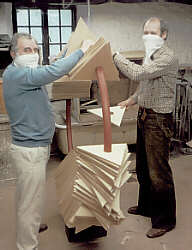
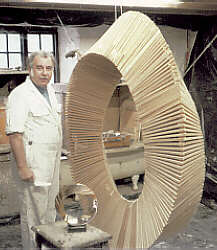
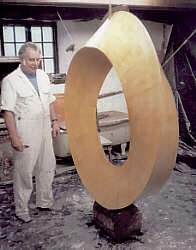
Roy Wakeford, Master Plasterer
- Helping to place the triangles on the central circle
- Fixing the triangles in place with the added twist
- With the finished plaster ready for the foundry
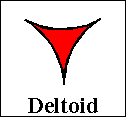 |
|
If the triangular fibre in ETERNITY is replaced by a deltoid then the resulting form occurs in singularity
theory and is known as the umbilic bracelet *. The USA artist and mathematician Helaman Ferguson has used symbolic computation to control the making of an exact
sculpture of this form. |
| If the fibre is taken to be three touching circles, and the twist
is eight times 120 degrees, then we obtain the GORDIAN KNOT. There is also an animation of this. |
|
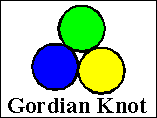 |
For a square, or for any object with four fold symmetry, the twist
could be any multiple of 90 degrees. A twist of 180 degrees yields
John's sculpture DEPENDENT BEINGS. In order to capture John's colouring of the faces of this, we
have made a rotating model from two bands, each of which is a fibre bundle over a circle
with fibre a line segment and a twist of 360 degrees.
What John has shown is that these forms which can be described
in exact mathematical terms can also, with the right choice of
proportions and with exact craftmanship, be made into objects
of astonishing beauty. The reasons for the choice of these proportions
are not at present part of the subject of mathematics.
Thus there are areas into which mathematics does not at present
venture.
But there are also areas into which it seems difficult for art
to venture, but into which mathematics does. The notion of a fibre
bundle is so general that it describes new kinds of objects which
are difficult to visualise as they may be realised properly only
in a space of many dimensions, or have to be constructed as a
concatenation of given forms and data. Suppose for example that
we replace the circular base of the Möbius Band by a more complex
object such as the surface of a sphere. The fibre could also be,
not a triangle or square, but one of the five Platonic solids,
for example a tetrahedron or a cube. How can we describe and understand
the geometry, the spatial interelations, of the objects which
result? How many different kinds of such objects are there? This
kind of curiosity is one of the motivating factors of mathematics.
We also see the standard problem types of representation and classification. Such problems are seen again in the study of knots, as shown
in the Knot Exhibition.
Such curiosity is also not idle. Objects of this kind arise in
descibing many physical situations and in many geometrical areas.
The tools which mathematicians have developed over many decades
to understand and calculate with these strange objects have been
found to be useful in a range of other parts of mathematics and
its applications.
In a further page, Classification, we discuss the deeper problem of classifying in various ways
objects that may be constructed as fibre bundles.
*...`Geometric Differentiation for the intelligence of curves and
surfaces', by I.R.Porteous, Cambridge University Press 1994, page
134.

© Mathematics and Knots/Edition Limitee 1996 - 2002
This material may be used freely for educational, artistic and
scientific purposes, with acknowledgement, but may not be used
for commercial purposes, for profit or in texts without the permission
of the publishers.





